REPORT ON THE IMPLEMENTATION OF THE 2008 PLAN FOR
NATIONAL ECONOMIC AND SOCIAL DEVELOPMENT
AND ON THE 2009 DRAFT PLAN FOR NATIONAL
ECONOMIC AND SOCIAL DEVELOPMENT
National Development and Reform Commission
I. Implementation of the 2008 Plan for National Economic and Social Development
II. Overall Requirements and Major Objectives for Economic and Social Development in 2009
III. Major Tasks and Measures for Economic and Social Development in 2009
Fellow Deputies,
The National Development and Reform Commission has been entrusted by the State Council to report on the implementation of the 2008 plan for national economic and social development and on the 2009 draft plan for national economic and social development for your deliberation and approval at the Second Session of the Eleventh National People's Congress (NPC), and also for comments and suggestions from the members of the National Committee of the Chinese People's Political Consultative Conference (CPPCC).
I. Implementation of the 2008 Plan for National Economic and Social Development
The year 2008 was an extraordinary and eventful year for China. Our country's economic and social development experienced a variety of severe challenges and tests that were hardly anticipated and rarely seen. Under the leadership of the Communist Party of China (CPC), the people of all our ethnic groups thoroughly applied the Scientific Outlook on Development, followed the plan for national economic and social development adopted at the First Session of the Eleventh NPC, surmounted numerous difficulties, and eliminated interference from emergencies of all kinds. Finally, we won great victories in dealing with the devastating snow and ice storms in parts of the south and the massive earthquake that hit Wenchuan, Sichuan Province. We successfully held the Beijing Olympic and Paralympic Games and accomplished the Shenzhou VII manned spaceflight mission. In particular, we actively responded to the severe impact of the global financial crisis, sustained steady and fairly rapid economic development and maintained social harmony and stability. The Plan for 2008 was, on the whole, implemented well.
1. The economy grew steadily and rapidly.
China's GDP topped 30 trillion yuan in 2008, a year-on-year increase of 9.0 percent and more than five percentage points higher than the average world economic growth rate. The value-added of large industrial enterprises increased by 12.9 percent over 2007, with that of light and heavy industries rising 12.3 percent and 13.2 percent respectively. Retail sales of consumer goods rose 21.6 percent to 10.85 trillion yuan, up 4.8 percentage points. Fixed asset investment across the country totaled 17.23 trillion yuan, up 25.5 percent. Domestic demand, particularly consumer demand, played a greater role in boosting economic growth.
Figure 1. China's GDP Growth Compared to the World Average
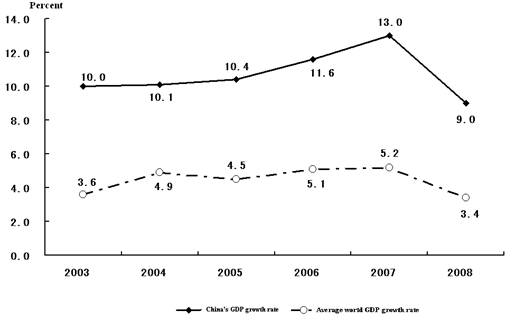
Economic performance continued to improve. National revenue reached 6.13 trillion yuan in 2008, up 19.5 percent year on year. Energy consumption per unit of GDP continued to decline in 2008, down 4.59 percent. Sulfur dioxide emissions and chemical oxygen demand kept falling, down 5.95 percent and 4.42 percent respectively, and this trend became more firmly set. Water consumption per 10,000 yuan of value-added by industry dropped by 7.0 percent. Efforts were intensified to use land more economically and intensively, resulting in continued improvement in land-use efficiency.
2. There was a gradual decline in the rate of price increase.
We adopted comprehensive policies and measures to counteract the great pressure that ballooning domestic food prices and the surge in the prices of grain and oilseed on the international market in the first half of 2008 placed on our efforts to stabilize prices. On the one hand, we worked to ensure adequate supplies. We formulated and implemented supporting policies to boost grain, oilseed and egg production and hog and dairy farming. We strengthened the emergency allocation and transport of important farm and sideline products, improved coordination between their production and sale, and alleviated problems concerning the sale and distribution of grain in northeast China and farm products in some areas, especially disaster-stricken areas. We took measures that combined fiscal and tax policy support, export controls, import inducements and manipulation of state reserves to ensure adequate market supplies and steady prices for important commodities such as grain, refined petroleum products and fertilizer. On the other hand, we strengthened market oversight. We instituted temporary measures to hold down the prices of grain, edible vegetable oil and other important commodities. We organized and carried out inspections focused on prices for agricultural supplies, refined petroleum products, medical care and drugs, and charges related to farmers, enterprises and education; actively encouraged business managers to exercise self-discipline in setting prices; and severely cracked down on violations of the law such as hoarding for speculation and colluding to drive up prices. At the same time, we raised the level of the cost of living allowances twice to ensure that the basic living standard of low-income groups would not be significantly affected by price increases. Beginning in the fourth quarter, the inflationary pressure subsided considerably. The consumer price index (CPI) rose by 5.9 percent for the year. The rate of price increase for means of production, including agricultural supplies, also fell rapidly, with producer prices for means of production in December down 1.9 percent year on year and the inflation rate for agricultural supplies down 12.4 percentage points from its July high.
Figure 2.Monthly CPI Changes in 2008
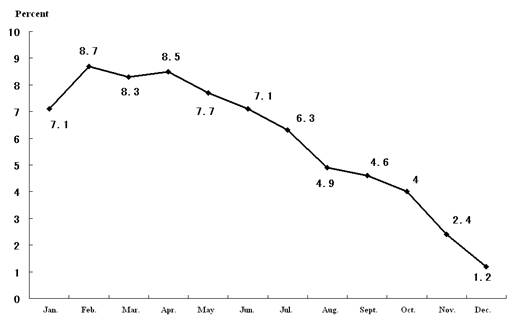
3. Work related to agriculture, rural areas and farmers was further intensified.
We constantly invigorated our policies to strengthen agriculture and benefit farmers and continued to intensify our efforts to protect farmland. We worked out ten measures to further support agriculture and grain production and organized the compilation of the Plan for Increasing the National Grain Production Capacity by 50 Billion Kilograms (2009-2020). We worked harder on the grain purchase prices, agricultural subsidies, and the purchase and storage of major farm products. We significantly raised minimum grain purchase prices three times, increasing them altogether by more than 20 percent. In addition, government allocations for direct subsidies to grain growers, general subsidies for agricultural supplies, subsidies for superior varieties of crops, and subsidies for the purchase of agricultural machinery and tools reached 103 billion yuan, up 100 percent from the previous year. We implemented the policy of temporary purchase and stockpiling of major agricultural products, and accordingly purchased 11.78 million tons of grain, 8.52 million tons of corn, 1.31 million tons of cotton and 670,000 tons of oilseed.
We continued to increase funding to support agriculture, rural areas and farmers. Central government allocations in this area rose 37.9 percent to 595.55 billion yuan in 2008. We moved faster to build production bases for grain, oilseed, sugar crops and cotton, and demonstration bases for drought-resistant agriculture. We made smooth progress in developing the system for preventing and controlling animal and plant epidemics, large-scale standardized livestock, poultry and aquatic farming operations, bases for cultivating superior varieties and breeds, the system for quality and safety inspection and testing of agricultural products, wholesale markets for farm products, grain and edible oil storage facilities, and modern logistics facilities.
The output of major farm and sideline products increased significantly. We had good harvests for five consecutive years, with last year's total output rising 5.4 percent to 528.5 million tons, a record high for both total output and yield per unit area. Cotton output reached 7.5 million tons in 2008; oilseed production was 29.5 million tons, up 14.8 percent, and sugar crop yield stood at 130 million tons, up 6.7 percent. Hog production recovered rapidly last year, and the total output of meat increased 5.9 percent to 72.69 million tons. Dairy farming also recovered gradually with total milk output up 3.6 percent. The output of aquatic products came to 48.95 million tons, up 3.1 percent. Further progress was made in developing high-quality, high-yield, and cost-efficient agriculture. Production of pollution-free agricultural products and green and organic foodstuffs and standardization of agricultural production were accelerated. High-quality wheat was planted in 68 percent of China's total wheat acreage, and high-quality rice accounted for 74 percent of the total rice acreage, up 6.3 and 1.9 percentage points respectively from the previous year.
Figure 3.Growth in Central Government Allocations for Agriculture, Rural Areas and Farmers
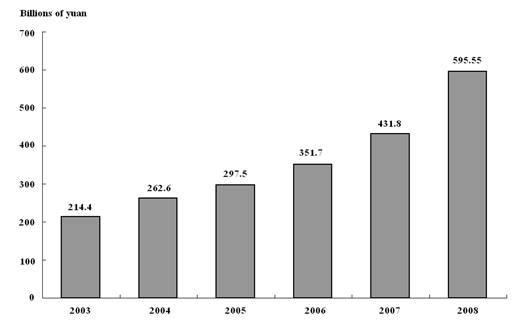
Figure 4. Growth in Grain Output
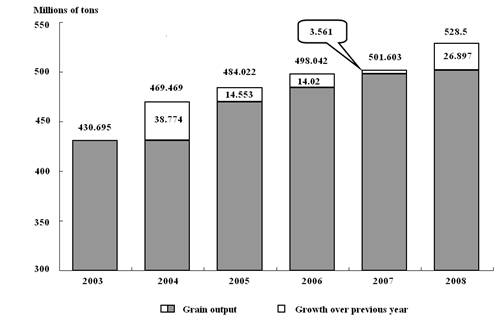
Working and living conditions continued to improve in rural areas. Implementation of the projects to reinforce dangerous reservoirs, and build auxiliary facilities and upgrade water-saving devices in large irrigated areas was sped up; work on the plan to upgrade large drainage pumping stations in the central region was completed ahead of schedule, and construction on a number of key water conservancy projects was begun. Development of water and power supplies, methane facilities and roads was further strengthened in rural areas. As a result, 48.24 million farmers benefited from the safe drinking water project; methane gas was made available to five million more households; an additional 391,000 kilometers of rural roads were built or upgraded last year. The project to encourage retailers to open stores in more townships and villages and the project to support 100 large wholesale markets for farm products and 100 large rural retail distributors both progressed smoothly.
4. Important progress was made in structural adjustment.
Our capacity for independent innovation continued to increase. The newly revised Law on Scientific and Technological Advances was promulgated and implemented in 2008. The Outline of the National Program for Long- and Medium-Term Scientific and Technological Development was implemented smoothly and its supporting policies were further improved. Funding for scientific and technological innovation was increased significantly. Expenditures on science and technology from the central budget in 2008 totaled 116.3 billion yuan, up 16.4 percent. The 16 major state science and technology projects, including development of large-scale oil and gas fields and ultra-large scale integrated circuits, all entered the implementation phase. Smooth progress was made in implementing the National Key Technology R&D Program, the March 1986 High-Tech Program, the March 1997 Program for Basic Research, and other science and technology programs. The third phase of the Knowledge Innovation Program was fully launched. Development of major state science and technology infrastructure such as the large sky area multi-object fiber spectroscopic telescope and the heavy ion research facility was completed, and they became operational. An additional 18 national engineering research centers were built in areas such as information technology, biotechnology and environmental protection; 76 more enterprise technology centers received state recognition; 90 enterprise technology centers received government support to enhance their innovation capacity. A 100 teraflops supercomputer was developed independently, and the new ARJ21-700 regional jet made a successful maiden flight.
Development of high-tech industries and equipment manufacturing was accelerated. Thirteen projects to apply biomedicine, satellite and other high technologies in production were implemented smoothly; 37 more high-tech industrial bases were certified in areas such as information technology, biotechnology, new energy sources, new materials, civil aviation and civil aerospace; three licenses were issued for third generation mobile communications. The value-added of the 54 national new and high technology development zones rose 18.6 percent in 2008. The policy framework to reinvigorate the equipment manufacturing industry was constantly improved, and R&D on a number of major equipment and key facilities was carried out successfully. The final assembly line for Airbus A320 was put into operation in Tianjin; R&D on the key equipment of the experimental demonstration line for transmitting 1,000-kilovolt AC ultrahigh-tension power was carried out successfully; mass production of megawatt wind power facilities was started. In addition, we continued to shut down backward production facilities in accordance with the law. Small thermal power plants with a total power generating capacity of 16.69 million kilowatts and 1,054 small coalmines were shut down last year, and shutdowns also progressed smoothly in the cement, steel and electrolytic aluminum industries. The growth of production in energy intensive and highly polluting industries slowed down significantly, and mergers and reorganizations of competitive enterprises in the steel, coal and building-material industries were accelerated.
Infrastructure and basic industries developed steadily. A total of nearly 100,000 kilometers of highways, including 6,433 kilometers of expressways, were opened to traffic in 2008. A total of 1,719 kilometers of newly built railway lines, 1,935 kilometers of double-track rail lines, and 1,955 kilometers of electric rail lines were put into operation. The Wuhan-Hefei Railway was completed, and construction was begun on the Beijing-Shanghai high-speed railway, Beijing-Shijiazhuang-Wuhan passenger line, trunk rail lines in the western region such as Lanzhou-Chongqing Railway and Guiyang-Guangzhou Railway, and a number of other major railway projects. Annual cargo handling capacity of berths for 10,000 ton-class or larger ships increased by 330 million tons; substantial progress was made in preparatory work on the Hong Kong-Zhuhai-Macao Bridge; eight more civilian airports were built last year, including ones in Kangding, Yulin and Changbaishan. Construction was begun on four nuclear power stations in Ningde and Fuqing, Fujian Province; Yangjiang, Guangdong Province; and Fangjiashan, Zhejiang Province. Work on a large coalmining base in Huainan and Huaibei coalmines was completed and passed acceptance inspection. The first phase of the state petroleum reserves project became operational. Coal output was 2.79 billion tons in 2008, up 4.1 percent, and installed power-generating capacity increased by 90.51 million kilowatts.
There was good development momentum in the service sector. Our policy system for supporting faster development of the service sector was constantly improved. IT-based demonstration pilot projects were implemented to provide comprehensive information services for building a new countryside, develop and provide computerized basic education resources, and provide e-commerce services for small and medium-sized enterprises. We set aside guidance funds to support development of the service sector, with the focus on developing a system of services for advanced manufacturing and a system of services for agricultural production. The value-added of tertiary industry rose 9.5 percent to 12.05 trillion yuan in 2008, the first time since 2003 that it grew faster than secondary industry.
Development became more balanced among regions. Construction was begun on ten more key projects for the large-scale development of the western region, with a total investment reaching 436.1 billion yuan. The follow-up policy to consolidate progress made in reforesting farmland was implemented, and an additional 5.23 million hectares of grazing land was returned to grassland. Rejuvenation of northeast China and other old industrial bases was accelerated. The first group of 12 cities dependent on now-depleted resources was designated, and a credit re-guarantee company was established for small and medium-sized enterprises in northeast China. We gradually implemented the policy for the central region, which calls for following the rejuvenation policy for northeast China and other old industrial bases in 26 cities of the region and the development policy for the western region in 243 counties or county-level cities and districts. Powerful momentum was maintained in developing clusters of cities in the central region, and encouraging progress was made in developing three different kinds of production bases and a system of integrated transportation hubs for the region. The eastern region continued to lead the country in changing the pattern of development, adjusting economic structure, and promoting institutional innovation. Guidelines on promoting reform, opening up and economic and social development in the Yangtze Delta area and the outline of the program for reform and development of the Pearl River Delta area were promulgated, and development and opening up in the special economic zones, the Shanghai Pudong New Area and the Tianjin Binhai New Area continued to deepen. A number of policies were formulated and implemented to support the development of old revolutionary areas, ethnic minority areas, border areas and poor areas. Cooperation between regions and cross-region one-to-one assistance continued to expand, and relocation of industries from the eastern region to the central and western regions progressed at a good pace.
5. Further progress was made in reform and opening up.
Economic restructuring continued to deepen. Overall rural reform was deepened and reform of the system of collective forest rights was carried out throughout the country. The reform to institute a corporate system or a stockholding system in state-owned enterprises and the pilot project to implement a board of directors system in wholly state-funded corporations progressed steadily, and outside directors now account for more than half of the board members in all 17 of the central government enterprises participating in the project. The trial reform of the budget system for state capital operations was extended to more areas. The restructuring of assets and business operations of telecommunication companies was basically completed, ushering in a competitive market dominated by three restructured telecom giants, China Mobile, China Telecom and China Unicom. Significant progress was made in restructuring the aviation industry, with the China Aviation Industry Corporations I and II being amalgamated into the Aviation Industry Corporation of China. Coordinated measures to encourage, support and guide the development of the non-public sector of the economy were continually improved. The new Law on Corporate Income Tax was implemented well. A plan for VAT reform was formulated and implemented. Important progress was made in the reforms of the Agricultural Bank of China and the China Development Bank. The capital strength, asset quality and risk resistance of the banking industry improved. The reform of the prices of resource products progressed steadily. The plans to reform the prices of refined petroleum products and related taxes and fees, which took years to formulate, were implemented smoothly. Guidelines on deepening the reform of the medical and health care system were finalized, and a plan was formulated to implement the reform from 2009 through 2011. Further progress was also made in the pilot reforms to promote comprehensive and sustainable development.
The open economy continued to grow. Foreign trade grew rapidly. Total imports and exports for the year reached US$ 2.5616 trillion, up 17.8 percent over 2007. The trade mix was further improved as evidenced by 17.3 percent growth in the export of mechanical and electrical products and 13.1 percent growth for new- and high-tech products. Trade in services expanded rapidly. Foreign investment was used more effectively. Management of foreign investment and loans was improved. Foreign direct investment in 2008 (excluding that in the banking, securities and insurance sectors) amounted to $92.4 billion, 23.6 percent higher than the previous year. Of this total, paid-in investment in the trade in services grew by 24.2 percent, and paid-in investment in the western and central regions increased by 79.8 percent and 36.4 percent respectively. A total of $23 billion of foreign loans were disbursed, a rise of 5.4 percent year on year. The state's foreign exchange reserves reached $1.95 trillion. Enterprises picked up the pace in making investment and undertaking cooperative projects overseas. Total overseas direct investment of Chinese enterprises (non-financial portion) for the year reached $40.65 billion, a rise of 63.6 percent over the previous year. Contracts for overseas projects and cooperation in the area of labor services maintained a rapid pace of development.
Figure 5.Export Shares of Mechanical and Electrical Products and New- and High-Tech Products
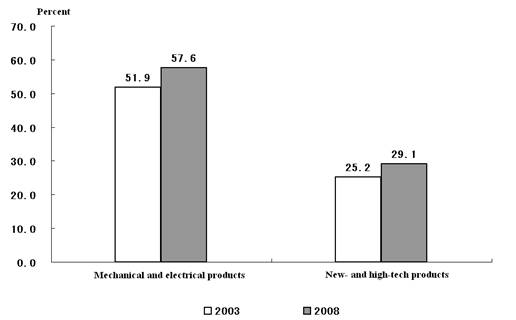
6. Efforts were intensified to improve people's lives and strengthen social programs.
The incomes of urban and rural residents continued to rise and they enjoyed greater benefits. Rural per capita net income reached 4,761 yuan and urban per capita disposable income came to 15,781 yuan, rising by 8 percent and 8.4 percent in real terms respectively. Policies to promote employment and to stimulate job creation by encouraging entrepreneurship were improved; 11.13 million new jobs were created for urban residents, and the registered urban unemployment rate stood at 4.2 percent at the end of the year. The social safety net continued to expand. There were 17.53 million people newly covered by urban basic old-age insurance, 93.87 million by urban basic medical insurance, 7.55 million by unemployment insurance, 16.37 million by workers' compensation and 14.06 million by maternity insurance. The level of basic old-age pensions for enterprise retirees was raised by 110 yuan per person per month. Trials of providing basic medical insurance for non-working urban residents were extended to 229 more cities. The new type of rural cooperative medical care system was set up in all targeted counties or county-level cities and districts. Further progress was made in developing the social security system for farmers whose land was expropriated. A total of 630,000 dwelling units of low-rent housing were built in urban areas, and the housing problem for a total of 1.9 million low-income urban families was resolved by providing them with low-income housing or granting them rent subsidies. Energetic progress was made in developing community-based services, children's welfare facilities, facilities for assisting and protecting homeless juveniles, and facilities providing comprehensive services for people with disabilities. Poverty alleviation through development was intensified, and the poverty line was raised again. Work-relief funds were used for developing 72,000 hectares of basic farmland. The potable-water problem was solved for 1.9 million people and 1.1 million heads of livestock in poverty-stricken areas. In the western region, 320,000 people were relocated from inhospitable places as a poverty relief effort.
Figure 6. Employment Growth in Urban Areas
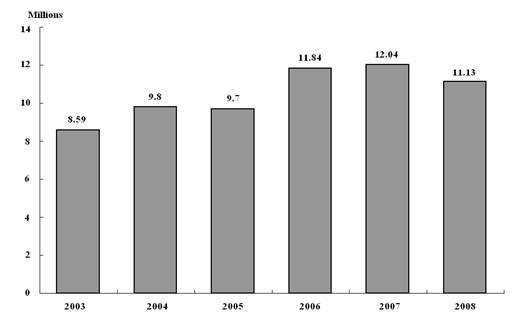
Social programs were strengthened. Free compulsory education was made universal in all urban and rural areas of the country. Vocational education developed at a faster pace. The system of financial aid for students from poor families was gradually improved. Conditions were improved in rural primary and junior secondary schools. A total of 6.89 million square meters of living facilities were built for 3,519 rural junior secondary schools. Support was provided for strengthening the infrastructure of 722 secondary vocational schools and county-level vocational education centers. There were 182 special education schools newly built, renovated or expanded. The third phase of the 211 Higher Education Project was begun. The secondary gross enrollment ratio was eight percentage points higher than the previous year. Regular undergraduate enrollment increased by 420,000, and graduate enrollment by 27,000. Development of community-level medical care services and family planning facilities was accelerated. Support was provided for building more than 20,000 clinics in towns and townships, 430 county hospitals, 209 Chinese medicine hospitals, and 369 maternity and child health centers. Special funds were used for developing 159 key Chinese medicine hospitals at or above the prefecture level, 1,231 county-level family planning service facilities and central family planning service stations for towns and townships, and more than 8,800 village clinics in remote areas plagued by serious infectious or endemic diseases. The natural population growth rate stood at 5.08‰. Support was significantly strengthened for programs such as extending radio and TV coverage to all villages, building multipurpose cultural centers in towns and townships, protecting cultural and natural heritage sites, and developing tourism. The press and publishing, literature and art, philosophy and the social sciences all prospered. The development of urban and rural public sports facilities was intensified.
7. Development of a resource-conserving and environmentally friendly society was accelerated.
Energy conservation and pollution reduction efforts were intensified. For the whole year, 42.3 billion yuan from the central treasury was spent to support construction on ten major energy conservation projects, development of the circular economy, upgrading of urban sewage and garbage treatment facilities and sewer lines, treatment of water pollution in key water basins, and strengthening of our energy conservation and environmental protection capacity. More than 60 million energy-efficient lights were distributed. The campaign to limit the production, sale and use of plastic bags achieved significant success. The national catalog of major energy-conserving technologies for extensive application was published. The construction and transportation sectors and public agencies made further progress in saving energy. We launched a science and technology initiative for energy conservation and emissions reduction, made breakthroughs in a number of major energy-conserving, pollution-reducing technologies in key industries, and widely demonstrated and applied these technologies in key areas and industries. The second round of demonstration trials for the circular economy was conducted smoothly, and trials for remanufacturing auto parts were begun in 14 auto enterprises. Economic policy played a bigger role in providing incentives. A preferential income tax policy for energy- and water-conserving and pollution-reducing equipment was promulgated. Excise tax rates for passenger vehicles of varied engine displacements were adjusted. The preferential tax policy concerning the comprehensive utilization of resources was improved. We developed a scheme for using surcharge and quotas to subsidize the price of electricity generated from renewable sources. Assessments were conducted on provincial governments' performance in meeting the targets and implementing the measures for energy conservation and pollution reduction in 2007. The results of evaluations of how well the 1,000 energy-intensive enterprises met energy conservation targets set for 2007 were made public. The campaign urging major energy-consuming enterprises to set, review and live up to the energy efficiency benchmarks progressed smoothly. A campaign was organized to supervise energy conservation and emissions reduction efforts and enforce environmental protection laws. Publicity activities to get the people to save energy and reduce pollution produced positive social effects.
Progress was made in ecological and environmental conservation. The projects to improve the ecosystems of the Tarim and Hei rivers and the Beijing water resources protection project were carried forward. The key project to restore the ecosystem of the Shiyang River was launched. While continuing to press ahead with major ecological projects, including virgin forest protection, development of shelterbelts and treatment of the sources of dust storms affecting Beijing and Tianjin, we launched a comprehensive project to prevent karst regions from turning into stony deserts. Work was energetically carried forward to improve the water environment of Taihu Lake and prevent and control water pollution in the Liao, Huai and Songhua rivers and other key water basins. The third phase of the project to prevent and control geological disasters in the Three Gorges Reservoir area was carried out smoothly. Environmental protection work was initiated on a broad scale in rural areas. Last year, the daily urban sewage treatment capacity was increased by 11.49 million tons, 65 percent of urban sewage was treated and 64 percent of urban household waste was safely handled, an increase of about two percentage points year on year in both cases. Further progress was made in the desulfurization of coal-fired power plants. Desulfurizing devices were installed in more thermal power plants with nearly 100 million kilowatt capacity, raising the percentage of the total capacity of the coal-fired plants equipped with such devices to around 60 percent.
Figure 7. Urban Sewage Treatment and Safe Handling of Urban Household Waste
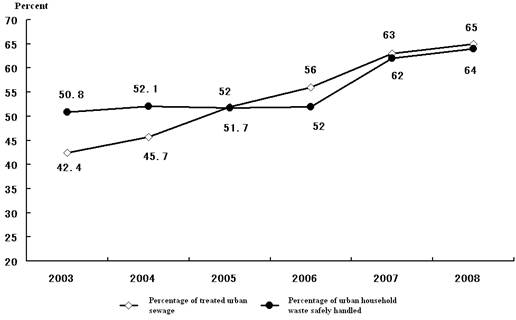
China's National Climate Change Program was implemented well. The white paper China's Policies and Actions for Addressing Climate Change was published. The Beijing High-Level Statement on Technology Development and Technology Transfer for Climate Change was adopted. Cooperation on projects concerning clean development mechanisms was energetically carried out.
8. Great success was achieved in fighting devastating natural disasters.
When parts of south China were hit with severe snow and ice storms at the beginning of the year, all localities and sectors, in accordance with the unified arrangements made by the central authorities, immediately set emergency response mechanisms in motion, did everything in their power to ensure transport, power supply and people's livelihood, and restored agricultural and industrial production as well as disaster-destroyed infrastructure in a short period of time. In the wake of the massive earthquake that hit Wenchuan, Sichuan Province on May 12, the whole nation was quickly mobilized. Forces of all kinds, including members of the People's Liberation Army, the Armed Police Forces, the militia, reserve forces, and public security personnel, as well as health workers, journalists, scientists and volunteers, responded promptly. Compatriots in Hong Kong, Macao and Taiwan and overseas Chinese made generous donations. The international community offered us a helping hand. Together, we achieved a great victory in the fight against the earthquake and wrote a moving, heroic paean memorializing our brave efforts. We pulled 84,000 survivors from the rubble, provided medical treatment to 2.96 million people who were injured or fell ill, and delivered aid to a total of 10.584 million people affected by the earthquake. In order to rebuild the disaster areas more effectively, the Regulations on Post-Wenchuan Earthquake Recovery and Reconstruction were formulated. With the approval of the NPC Standing Committee, a recovery and reconstruction fund was set up. The overall plan for recovery and reconstruction and ten specific plans were drawn up in a short period of time. Provinces (or province-level municipalities) were paired up with severely hit counties (or county-level cities), with each province providing assistance to its twin county. All recovery and reconstruction plans are being implemented quickly, and over 8,400 projects have been started already. Lives and production are returning to normal in the disaster-hit regions.
Despite drastic changes in the global economic and financial situation and a marked increase in unexpected difficulties at home, notable achievements were made in economic and social development in 2008, and none of them came easily. They would not have been possible without the strong leadership and scientific decision-making of the Party Central Committee and the State Council, close collaboration and hard work of all localities and sectors, or the resolve, unity and painstaking efforts of the people of all ethnic groups.
While fully recognizing these achievements, we are keenly aware that the global and domestic economic situations are grim and complex, and that the task of maintaining steady and fairly rapid economic growth has become more formidable. The spread of the international financial crisis has exerted an enormous impact on the global economy, and the breadth, depth and intensity of the impact have exceeded everyone's expectations: the economies of major developed countries might all fall into recession, emerging market economies and developing countries are experiencing slowdowns in growth, and the world economy will experience a long period of stagnation and adjustment. In addition, there has been mounting global deflationary pressure and resurging trade protectionism, which will add more uncertainties and instabilities. The impact of the global financial crisis and many outstanding problems at home have suddenly made it more difficult to keep our economy going strong. We have not yet improved the extensive pattern of development or solved institutional and structural problems, including poor independent innovation capacity, unsuitable industrial structure, imbalance between domestic and external demand, the high toll on natural resources and the environment, the disproportion between investment and consumption, and imbalances between economic and social development, between rural and urban areas, and between different regions. In particular, the slowdown in economic growth has become a significant economic problem since the fourth quarter of last year. First, industrial production declined significantly. The growth of value-added of large industrial enterprises dropped by 9.7, 11.9 and 11.7 percentage points year on year in October, November and December respectively. Demand for energy, raw materials and transport shrank; prices of products such as steel and electrolytic aluminum fell; the problem of excess production capacity became apparent. Second, some consumption hotspots cooled down. The total floor area of commodity housing sold throughout the year decreased by 19.7 percent. The growth of automobile sales was 15.1 percentage points less than the previous year. Demand for other commodities, consumption of which had grown fast in recent years, also shrank by varying degrees. Third, foreign trade dropped sharply, with exports down by 2.2 percent and 2.8 percent year on year in November and December respectively. Fourth, some enterprises faced the difficult situation of fewer orders, sluggish sales and reduced profits. These problems spread from coastal regions to the hinterland, from small- and medium-sized enterprises to large ones, and from export-oriented industries to other industries. Many more enterprises than before suffered losses.
Meanwhile, there are also acute problems concerning employment, agriculture, rural areas and farmers, energy conservation and pollution reduction and the financial sector. There has been mounting pressure on employment and reemployment. Enterprises' demand for workers decreased significantly. The number of people joining the urban workforce in October, November and December dropped each month, standing at 840,000, 550,000 and 380,000 respectively. The employment situation for college graduates, urban residents having difficulty finding jobs and rural migrant workers has become worse. There are many factors restraining the growth of agricultural production and farmers' incomes. Agricultural infrastructure remains weak. After five years of bumper harvests in a row, it will be very difficult to keep grain production growing steadily. There is great downward pressure on prices of farm products. The return home of many rural migrant workers and their difficulty in finding steady jobs makes it harder to keep rural residents' incomes growing. It is now more difficult to promote energy conservation and pollution reduction. Energy-conserving technologies and services are developing slowly due to the objective fact that they are still in the early stage of development. Moreover, because enterprises are facing more difficulties and some are not operating at full capacity, they spend less on technological upgrading and pollution reduction, which leads to a drop in their energy efficiency and ineffective operation of their pollution control equipment. Therefore, there will be great pressure to achieve energy conservation and pollution reduction targets in the last two years of the Eleventh Five-Year Plan period. Potential risks in financial markets cannot be ignored, and confidence in the capital market urgently needs to be strengthened. There is chaos in the market order of some sectors, and workplace accidents and major food safety incidents repeatedly occur, inflicting heavy losses on people's lives and property. We will take vigorous steps to solve the above problems and minimize their adverse impact.